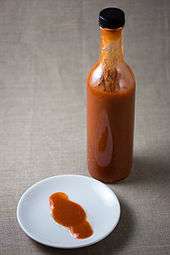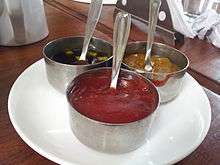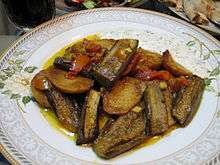Ajvar
Ajvar (pronounced: /ˈaɪvɑːr/; Serbian: ajвар / ajvar; Albanian: ajvari; Bulgarian: aйвар, romanized: ayvar; Macedonian: aјвар, romanized: ajvar; Bosnian: ajvar / hajvar; Turkish: ayvar) is a condiment made principally from red bell peppers and oil. Ajvar is used in Southeast Europe, in Serbian, Bosnian, Bulgarian, Croatian, Macedonian, Montenegrin, Albanian, and to a small degree the Slovenian cuisine. In Serbia, it was long known as "Serbian salad"[1] or "Serbian vegetable caviar".[2] It became a popular side dish throughout Yugoslavia after World War II and is nowadays popular in Southeastern Europe.
 Ajvar with bread, garlic, pepper and salami | |
| Region or state | Balkans |
|---|---|
| Main ingredients | Bell peppers, oil, salt |
Homemade ajvar is made of roasted or cooked peppers. Depending on the capsaicin content in bell peppers and the amount of added chili peppers, it can be sweet (traditional), piquant (the most common), or very hot (ljutenica). Ajvar can be consumed as a bread spread or as a side dish. Ajvar has a few variations. Ajvar containing tomato is called pindjur and if it contains eggplant it is called malidzano.
Etymology and origin
The name ajvar comes from the Turkish word havyar, which means "salted roe, caviar" shares an etymology with "caviar".[3] Prior to the 20th century, significant local production of caviar occurred on the Danube, with sturgeon swimming from the Black Sea up to Belgrade.[4] Domestic ajvar, meaning "caviar", used to be a very popular dish in Belgrade homes and restaurants, [5] but the domestic production of caviar was not steady starting in the 1890s because of labor disputes. Eventually a special pepper salad was offered as a substitute in Belgrade restaurants under the name "red ajvar" (crveni ajvar) or "Serbian ajvar" (srpski ajvar).[6]
The origin of ajvar is disputed; North Macedonia and Serbia claim to be the original creators of the recipe.
Preparation
.jpg)
Homemade ajvar is made of roasted peppers, while some industrial producers use cooked peppers, which leads to a lower quality. Ajvar preparation is somewhat difficult, because it requires considerable manual labour, particularly for peeling the roasted peppers. Traditionally, people prepare it in mid-autumn, when bell peppers are most abundant, and preserve it in glass jars for consumption throughout the year. Anecdotally, most households' stocks do not last until the spring, when fresh vegetables become available, so it is usually enjoyed as a winter food. Often, the whole family or neighbours gather to prepare the bell peppers. The principal cultivar of pepper used is called roga (i.e. "horned"). Roga is large, red, horn-shaped, with thick flesh and relatively easy to peel. It typically ripens in late September.
To produce ajvar, bell peppers are roasted whole on a plate on an open fire,[7] a plate of wood in a stove, or in an oven. The baked peppers must briefly cool to allow the flesh to separate from the skin. Next, the skin is carefully peeled off and the seeds are removed. The peppers are then ground in a mill or chopped into tiny pieces (this variant is often referred to as pindjur). Finally, the resulting mush is stewed for several hours in large pots. Sunflower oil is added at this stage to condense and reduce the water, and to enhance later preservation. Salt (and sometimes vinegar) is added at the end and the hot mush is poured directly into sterilized glass jars, which are sealed immediately.
Production

Ajvar is produced in various countries, including Bosnia, Croatia, Serbia, Albania, and North Macedonia. Serbia's reported annual production is 640 tons.[8]
Ajvar is one of the so-called zimnica (winter foods), which include pickled chili peppers, pickled tomatoes, and anything else that can be preserved in a jar just before winter.
See also
- Ljutenica, a similar relish in Bulgarian, Macedonian and Serbian cuisines
- Pindjur, a similar relish in Bulgarian, Macedonian and Serbian cuisines
- Zacuscă, a similar relish in Romanian cuisine
- Kyopolou, an eggplant-based relish in Bulgarian and Turkish cuisines
- Biber salçası, a Turkish paste made from red peppers alone
- Lecso, a similar Hungarian (also made in parts of Slovakia and Serbia) stewed red pepper, onion, and garlic dish
- List of spreads – Wikipedia list article
- Achar – Foods originating from the Asian subcontinent, pickled from certain varieties of vegetables and fruits, a similar relish of Indo-European origin in South Asian cuisines
References
- Joseph Slabey, ed. (1949). Slavonic Encyclopaedia. p. 338.; Lovett Fielding Edwards (1954). Introducing Yugoslavia. p. 79.; The World and it's peoples. 1965. p. 45.; Pavla Zakonjsek (1966). Praktična kuharica (Slovenian cookbook) (in Slovenian). p. 123.; Joseph Wechsberg (1960). The Cooking of Vienna's Empire. p. 164.; Thelma Barer-Stein (1979). You eat what you are: a study of ethnic food traditions. p. 576.; John Masson (1977). Lets go to Yugoslavia. p. 70.; Vera Lévai. Culinary delights. pp. 62, 169.; Malcolm Burr (1935). Slouch hat. p. 165.
- Joseph Wechsberg (1960). The Cooking of Vienna's Empire. p. 164.; Thelma Barer-Stein (1979). You eat what you are: a study of ethnic food traditions. p. 576.; James Hillman; Charles Boer (1985). Freud's Own Cookbook. Harper & Row. p. 134. ISBN 978-0-06-091159-1.
- Etimološki rečnik srpskog jezika I, 2003, s.v. ajvar
- Josip Pančić (1860). Pisces Serbiae. p. 33.; Mihailo Petrović (1941). Đerdapski ribolov.
- "Belgrade through the ages". 7. 1960: 61, 64. Cite journal requires
|journal=(help); Dušan J. Popović (1964). Beograd kroz vekove. pp. 93, 215, 241. - Malcolm Burr (1935). Slouch hat. p. 165.; Lovett Fielding Edwards (1954). Introducing Yugoslavia. p. 79.
- "Wayback Machine". Web.archive.org. 16 July 2011. Archived from the original on 16 July 2011. Retrieved 15 December 2017.
- "Vegetable Industry in Serbia" (PDF). Serbia Investment and Export Promotion Agency.
External links
- "Fall Brings Red Peppers and Ajvar, 'Serbian Salsa'". NPR. November 8, 2006. (article and recipe)
- "Ajvar srpski kavijar" (in Serbian). Novosti. 2013.
- "Leskovčanka po čijem receptu je brendiran srpski ajvar ušla u biznis kad je ostala bez posla". Blic (in Serbian). 2012.
- "Ajvar - Top-notch gastronomic delight, vegan soul food, recipes and origin". Ajvar.com. 2017.



